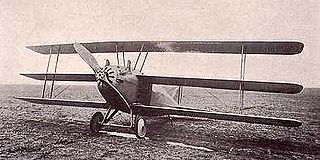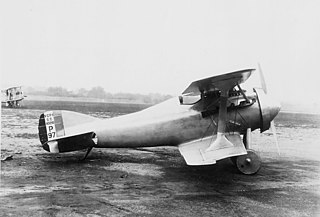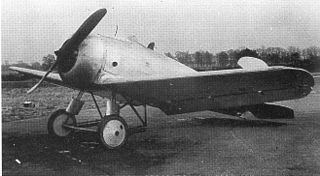
The Curtiss SOC Seagull was an American single-engined scout observation seaplane, designed by Alexander Solla of the Curtiss-Wright Corporation for the United States Navy. The aircraft served on battleships and cruisers in a seaplane configuration, being launched by catapult and recovered from a sea landing. The wings folded back against the fuselage for storage aboard ship. When based ashore or on carriers the single float was replaced by fixed wheeled landing gear.

The Hall XPTBH was a prototype American twin-engined seaplane, submitted to the United States Navy by the Hall Aluminum Aircraft Corporation in response to a 1934 specification for new bomber and scout aircraft. Constructed in an innovative fashion that made extensive use of aluminum, the XPTBH proved successful in flight testing, but failed to win favor with the U.S. Navy. No production contract was awarded, and the single aircraft built served in experimental duties before its destruction in a hurricane during 1938.

The Curtiss SC Seahawk was a scout seaplane designed by the Curtiss Aeroplane and Motor Company for the United States Navy. The existing Curtiss SO3C Seamew and Vought OS2U Kingfisher were gradually replaced by the Seahawk in the late stages of the war and into peacetime.

The Curtiss SO3C Seamew was developed by the Curtiss-Wright Corporation as a replacement for the SOC Seagull as the United States Navy's standard floatplane scout. Curtiss named the SO3C the Seamew but in 1941 the US Navy began calling it by the name Seagull, the same name as the aircraft it replaced, causing some confusion. The British Royal Navy kept the Curtiss name, (Seamew), for the SO3Cs that they ordered. One of the US Navy's main design requirements was that the SOC Seagull's replacement had to be able to operate both from ocean vessels with a single center float and from land bases with the float replaced by a wheeled landing gear.

The Boeing Model 15 was a United States single-seat open-cockpit biplane fighter aircraft of the 1920s, manufactured by the Boeing company. The Model 15 saw service with the United States Army Air Service and with the United States Navy as a carrier-based fighter.

The Curtiss F6C Hawk was a late 1920s American naval biplane fighter aircraft. It was part of the long line of Curtiss Hawk airplanes built by the Curtiss Aeroplane and Motor Company for the American military.

The Naval Aircraft Factory TS-1 was an early biplane fighter aircraft of the United States Navy, serving from 1922 to 1929.

The Curtiss 18T, unofficially known as the Wasp and by the United States Navy as the Kirkham, was an early American triplane fighter aircraft designed by Curtiss for the US Navy.

The Curtiss R3C was an American racing aircraft built in landplane and floatplane form. It was a single-seat biplane built by the Curtiss Aeroplane and Motor Company.

The Curtiss CR was a racing aircraft designed for the United States Navy in 1921 by Curtiss. It was a conventional single-seater biplane with a monocoque fuselage and staggered single-bay wings of equal span braced with N-struts. Two essentially similar landplane versions were built as the CR-1 and CR-2, which were both eventually converted to seaplanes as the CR-3 in 1923 and CR-4 in 1924. A refined version was developed for the US Army Air Service under the designation R-6. These latter two aircraft featured refined aerodynamics included surface-mounted radiators.

The Curtiss CS was a reconnaissance and torpedo bomber aircraft used by the United States Navy during the 1920s. It was a large single-engine biplane with single-bay unstaggered wings, the design conventional in all respects other than that the lower wing was of greater span than the upper. The CS was built to allow its undercarriage to be quickly and easily interchangeable between wheeled, tailskid undercarriage, and twin pontoons for operation from water. Provision for the carriage of a torpedo was semi-recessed into the underside of the fuselage, blended in behind an aerodynamic fairing. The pilot and gunner sat in tandem open cockpits, while accommodation inside the fuselage was provided for a third crewmember who served as bombardier and radio operator. This station was also provided with a dorsal hatch aft of the gunner's position, and a ventral blister aft of the torpedo recess, which was used for aiming bombs or torpedoes.

The Curtiss Fledgling, known internally to Curtiss as the Model 48 and Model 51 was a trainer aircraft developed for the United States Navy in the late 1920s and known in that service as the N2C.

The Curtiss Model R was a utility aircraft produced for the United States Army and Navy during World War I. It was a conventional, two-bay biplane with slightly staggered wings of unequal span. The aircraft was provided with two open cockpits in tandem and fixed tailskid undercarriage, but many were built for the Navy with twin floats replacing the wheels. During the course of the war, Model Rs were used for general liaison and communication duties, as well for observation, training, and as air ambulances. In practice, the Curtiss powerplants supplied with these aircraft proved insufficient and were mostly replaced with Liberty engines. The Navy's Model R-3 floatplane had extended-span, three-bay wings, and was intended for use as a torpedo bomber. Some of these were later fitted with wheeled undercarriage and transferred to the Army as bombers under the designation Model R-9.

The Seversky SEV-3 was an American three-seat amphibian monoplane, the first aircraft designed and built by the Seversky Aircraft Corporation.

The Berliner-Joyce OJ was an American biplane observation floatplane developed by the Berliner-Joyce Aircraft for the United States Navy during the early 1930s.

The Verville VCP was an American single-engined biplane fighter aircraft of the 1920s. A single example of the VCP-1 was built by the United States Army Air Service's Engineering Division, which was later rebuilt into a successful racing aircraft, while a second, modified fighter was built as the PW-1.

The Handley Page Type S, or HPS-1 was a prototype British carrier-based fighter developed for the United States Navy in the early 1920s. A low-wing monoplane, it was unsuccessful, only two being built and flown.

The Curtiss CT-1 model 24, a twin engine torpedo bomber mounted on floats, was first flown in 1921.

The Curtiss CA-1 was an American five-seat biplane amphibian designed by Frank Courtney and built by Curtiss-Wright at St Louis, Missouri.

The Curtiss Model 22 Cox Racers were two specialised racing aircraft built by the American Curtiss Aeroplane and Motor Company. The type was flown as a monoplane, biplane and triplane.






















